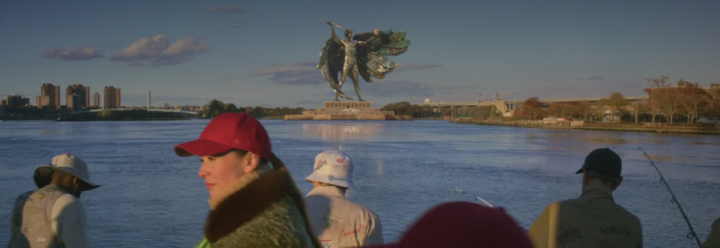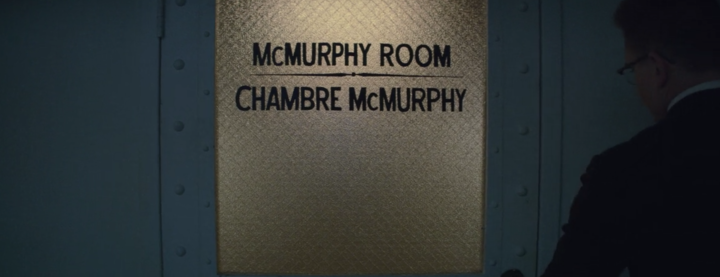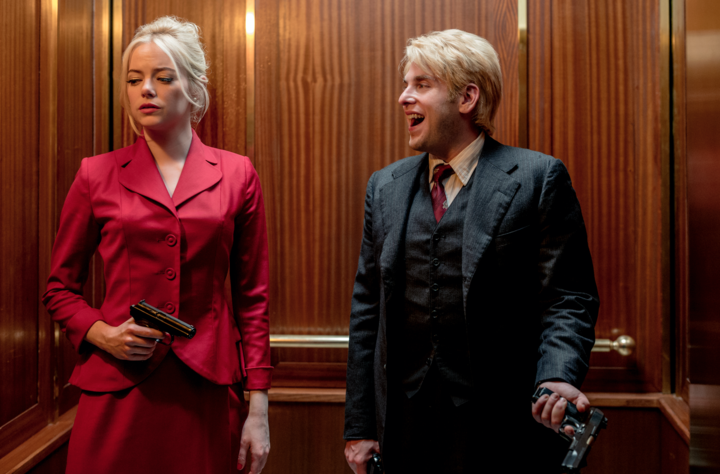[ad_1]
Welcome back, subjects. Welcome back.
After taking a 10-episode dose of Netflix’s new show “Maniac,” you might find yourself feeling disoriented, bloated from binge-watching and just generally in a dazed state of, “Uh, wait. What?”
Don’t worry. This is a normal reaction to Jonah Hill and Emma Stone’s new show.
For those who need catching up, “Maniac” takes place in a sort of retro future New York where nothing has changed much aesthetic-wise since the 1980s and everything is just “weird parallels to what already exists,” director Cary Fukunaga explained to HuffPost.
Instead of pop-ups that bombard browsers with ads online, actual “ad buddies” bombard people with product pitches on the subway. Instead of Facebook friend requests that make rekindling a long-lost friendship seem feasible, there’s a friend proxy service that sends actors to re-enact reunions without all the fuss.
Amid this gentle hellscape, Hill’s Owen Milgrim and Stone’s Annie Landsberg find themselves in a pharmaceutical drug trial led by Justin Theroux’s Dr. James K. Mantleray that promises to cure their every mental health problem. Therapy, Dr. Mantleray purports, will soon be a thing of the past, thanks to his trio of experimental (and possibly addictive) pills.
Or maybe not. Instead of being cured, Owen and Annie are thrown into a delusional adventure realm involving everything from a Long Island lemur heist to some light “Lord of the Rings” cosplay. Taken together, “Maniac” is a hodgepodge of color and sound that feels as discombobulating as a drug trip.
So, during roundtable interviews with the cast and creators, HuffPost cleared up as many mysteries as we could.
At its core, Fukunaga believes the show’s message is simple: It’s about “radical acceptance of self and connecting with other people,” he said.
“It’s OK to not feel OK,” Stone added.
But you know what’s not OK? Getting caught up in the dystopia’s minor details, wondering how each and every one of Owen and Annie’s hallucinations fit into the last. Are they even hallucinations, or as Annie says, some “multi-reality brain magic shit”?
OK, first off, is it “multi-reality brain magic shit,” or were Jonah Hill and Emma Stone just dreaming?
Throughout the course of their pharmaceutical drug trial ― the extremely risky experiment both subjects voluntarily agreed to participate in ― Owen and Annie are strategically dosed with three pills, hooked up to a machine that sends microwaves directly into their brains, and launched into ever-escalating shared visions of what appear to be alternate realities featuring slightly or drastically different versions of themselves.
But they’re just dreams.
As Fukunaga explained, “My way into this is that dreams are a way of tapping into your unconscious mind, and that therein lies a lot of the structure for our choices in life and motivations and also traumas. So using dream logic [to get to] an exploration of the unconscious mind seemed appropriate.”
Why is there a Statue of Extra Liberty?

Netflix
Answer: “Someone” decided we needed more.
In the first episode of “Maniac,” we learn Owen might be hallucinating an alternate version of his brother Jed, who goes by the name Grimson. From that point on, it’s hard not to assume each and every aberration Owen experiences is a hallucination too, like the Statue of Extra Liberty that an errant tour guide notes.
Did the Statue of Liberty get replaced? Was it a mispronunciation? Just… what?
In the “Maniac” version of New York City, the Statue of Extra Liberty is real, and just another indicator that the show takes place in an alternate reality similar to, but not the same, as our own.
According to writer Patrick Somerville, the area the tour guide is referring to is “not actually the harbor” that contains the real Statue of Liberty. That statue exists in his version of NYC, but “then there’s another statue in the north end of the city called the Statue of Extra Liberty, so we have both now.”
“Someone decided we needed more,” he concluded.
“We needed more liberty, clearly,” Theroux agreed.
Speaking of Grimson, is he real?

Netflix
Upon meeting Grimson, it might be tempting to think he’s real. Maybe he’s not just a figment of Owen’s imagination! Perhaps he’s Jed’s long-lost twin brother, and Owen is being made to believe his interactions with him are delusions in order to keep the unwanted Grimson away from Owen’s well-to-do Milgram family and their poop bot empire (those little robots we saw cleaning up the streets).
“It’s sad,” said Grimson actor Billy Magnussen. “Owen came from a family, for lack of a better word, of winners, and he wasn’t. He had all this negative energy blocking him out and pushing him away, and the fact that he had to manifest an identity [so] that he could connect with his family ― it’s tragic that he had to create that for him to feel like he is a part of something.”
“I do think it is a fake character and not real,” Magnussen admitted. “It’s sad that Owen had to do that.”
What happened to McMurphy?

Netflix
Answer: Nothing. McMurphy is a One Flew Over the Cuckoo’s Nest reference.
Throughout the drug trial in “Maniac,” characters like Sonoya Mizuno’s Dr. Azumi Fujita talk about the “old problems” that plagued past drug trials and her desire to avoid any “McMurphies.”
So what happened to McMurphy? To answer that, we need author Ken Kesey.
Sommerville explained that in “Maniac,” a McMurphy is “someone whose brain is scrambled. Basically, that’s a One Flew Over The Cuckoo’s Nest reference. That’s why Mantleray presumably named it McMurphy. They call it McMurphy when they lose someone [during a trial].”
In the film adaptation of Kesey’s book, Jack Nicholson plays Randle Patrick McMurphy, who receives a lobotomy by the tragic story’s end. You don’t witness anyone getting “McMurphied” in “Maniac,” but it “happened a bunch of times in the past,” said Somerville.
What was Annie’s dad doing inside that weird machine?

Netflix
Answer: Avoiding the world.
Early on in “Maniac,” Annie heads to her dad’s house and ends up talking to a large machine in his backyard that talks back. Viewers are left wondering whether that machine is simply speaking on her father’s behalf, holding his consciousness or containing his whole being.
Is he actually inside the box?
“Yeah … in my mind, my dad was in that box,” Stone confirmed.
That machine, called the A-Void (presumably because people use it to avoid the world), is just one of the many kooky inventions Fukunaga planned for the show. He told us about one that didn’t make it to the final cut: a “therapeezy booth” for coin-operated therapy sessions, which you could’ve found in subway stations.
“It’s almost like a phone sex line, but it’s therapy,” Fukunaga said.
Why does Owen hate Balderdash?
Answer: It’s all about lies.
Perhaps the most confusing moment in the entire show — or in my entire life — occurs when Owen proclaims Balderdash to be “bullshit.” Balderdash is fun (probably the most fun board game, in my opinion). So Owen’s disdain for it is just perplexing.
But according to Fukunaga, there’s a simple explanation: “Owen hates Balderdash because it’s all lies. It’s all bullshit. It’s everyone basically trying to lie to each other better than the other person, and he wants truth.”
Stone added that her character would “love Balderdash.”
“Annie would be really good,” she said, which Fukunaga backed up. “Annie would fucking kill at Balderdash.”
(Mattel has not yet responded to my request for comment on Balderdash being “bullshit.”)
Do Annie and Owen end up together?
Answer: Hell no. Haven’t you been watching?
Annie and Owen share a lot during the trials of “Maniac.” In their shared dreams, they’re either married, partners in espionage or a mismatched hawk-elf duo attempting to reunite. When they meet, Owen believes he’s destined, according to Grimson, to partner with Annie.
So when all’s said and done, are they romantically attached?
The “Maniac” finale kind of spells the answer to this question when Annie rejects her proxy friend Owen’s marriage proposal. Their relationship: It’s not like that.
“I’ve never seen a show with 10 full episodes, like a whole season, where a female character doesn’t have a love interest and isn’t focused on that,” Stone explained, praising “Maniac” for doing just that. “She’s getting over trauma in her life, and she’s self-focused and she makes a friend.”
8. So … who is the Maniac?

Netflix
Follow up: So why isn’t it called “Maniacs” then?
“Well, we didn’t want to call it ‘Maniacs’ because it doesn’t sound as good,” said Somerville. “To me, everyone in the show.”
Theroux added, “Everyone’s a maniac. I mean, which is true in life also … there’s no one untouched by trauma or damage or some form of mental tic, I guess some more extreme than others.”
Bonus: What about the other unanswered questions?
Answer: They’re going to stay unanswered.
Fukunaga and the cast wouldn’t answer all of our questions. For instance, what does ULP, the drug program Owen and Annie enter, actually stand for? For now, it’s a mystery.
Fukunaga says he doesn’t like leaving major questions unanswered. The director says it’s the “worst” when movies conclude with an air of “I don’t know, what do you think happened?” But he does like to leave some things for fans to ponder.
“I think conversation and debate is always a great thing,” he said.
Maybe just chalk it all up to brain magic shit.
[ad_2]
Source link

